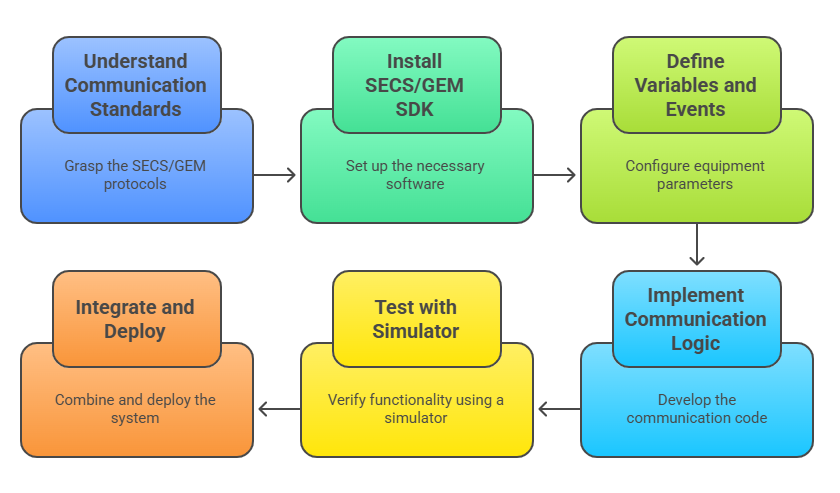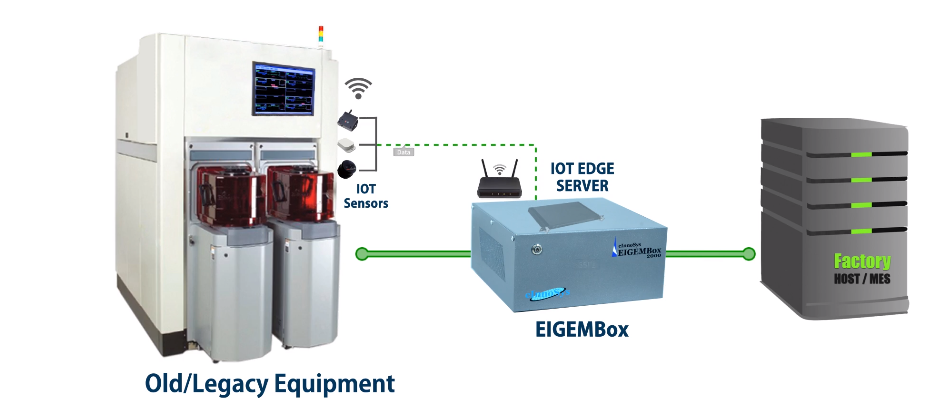
In the semiconductor industry, automation is essential to improve efficiency, quality, and throughput. To achieve complete automation, communication between manufacturing equipment and the factory host system must follow standard protocols. One of the most widely adopted communication standards is SECS/GEM — defined by the SEMI (Semiconductor Equipment and Materials International) organization.
If you’re developing equipment software or integrating legacy tools into a modern fab automation environment, using a SECS/GEM SDK (Software Development Kit) is the best way to accelerate implementation. In this guide, we’ll explore what SECS/GEM SDKs are, why they’re crucial, and how to get started step—by—step—based on insights from Einnosys’ SECS/GEM solutions such as EIGEMBox and EIGEMEquipment.
What Is SECS/GEM and Why It Matters
SECS/GEM (SEMI Equipment Communication Standard / Generic Equipment Model) defines how semiconductor manufacturing equipment communicates with factory host systems.
It ensures interoperability, real-time data exchange, event handling, and command control.
Key Benefits:
- Enables factory automation and real-time monitoring
- Standardizes communication between diverse tools
- Supports data collection, alarms, and recipe management
- Essential for Industry 4.0 and smart manufacturing initiatives
However, implementing SECS/GEM from scratch can be complex and time-consuming. This is where a SECS/GEM SDK simplifies the process.
What Is a SECS/GEM SDK?
A SECS/GEM SDK is a prebuilt software toolkit that helps equipment developers quickly add SECS/GEM communication capabilities to their systems.
It typically includes:
- SECS/GEM libraries (DLLs / APIs)
- Configuration tools for message definitions and event handling
- Testing utilities (like host simulators and message monitors)
- Documentation and sample code
Using an SDK drastically reduces development effort, testing time, and integration risks — allowing teams to focus on equipment logic instead of communication layer implementation.
Why Choose Einnosys SECS/GEM SDKs
Einnosys provides multiple SECS/GEM integration tools designed to meet the diverse needs of equipment and fab automation at various stages.
EIGEMEquipment is an SDK toolkit that enables equipment manufacturers to quickly make their tools SECS/GEM-compliant.
It supports both SEMI E30 (GEM) and E37 (HSMS) standards, enabling seamless communication with factory hosts.
Key Capabilities:
- Predefined SECS/GEM message templates
- Configurable event reports and data collection
- Supports GEM control states, equipment status variables, and alarms
- Easy integration with tool controller software
- Works on Windows and Linux platforms
- Minimal coding required


EIGEMBox
EIGEMBox is a turnkey SECS/GEM interface solution for legacy or non-GEM equipment.
It allows older 150mm/200mm tools to connect to modern factory automation systems without modifying the existing controller software.
Key Features:
- External hardware/software gateway for SECS/GEM conversion
- Plug-and-play communication between legacy tools and fab host
- Supports recipe upload/download, trace data, and alarms
- Ideal for equipment without native SECS/GEM support
- Fast deployment and easy configuration
Step-by-Step Guide to Getting Started with a SECS/GEM SDK
Let’s look at how you can set up and start using a SECS/GEM SDK like EIGEMEquipment for your equipment development.

Step 1: Understand the Communication Standards
Before coding, familiarize yourself with:
- SEMI E5 (SECS-II) – Message structure and data format
- SEMI E30 (GEM) – Equipment communication model
- SEMI E37 (HSMS) – TCP/IP-based message transport protocol
Understanding these standards ensures correct configuration of messages, variables, and event reports.
Step 2: Install the SECS/GEM SDK
Once you obtain the SDK (e.g., EIGEMEquipment SDK):
- Install it on your development machine (Windows/Linux).
- Set up the runtime environment and dependencies.
- Review the SDK documentation for supported APIs and configuration files.
Einnosys SDKs come with example applications that help you test GEM scenarios right out of the box.
Step 3: Define Equipment Variables and Events
In your tool’s control software:
- Identify status variables (SVs) (e.g., temperature, pressure, motor state).
- Define collection events (CEs) (e.g., wafer load, process complete).
- Configure alarms for fault conditions.
Using the SDK’s configuration editor, you can map each variable/event to the appropriate SECS message format.
Step 4: Implement Communication Logic
Use the SDK’s APIs to:
- Establish a connection with the Host (via HSMS/TCP).
- Send and receive SECS messages (SxFy format).
- Handle host commands and responses.
- Update status data and report events as they occur.
The EIGEMEquipment SDK simplifies this process with ready-to-use C++/C# interfaces.
Step 5: Test Using a SECS/GEM Simulator
Before deploying to production, test communication using a SECS/GEM simulator like EIGEMSim.
This tool simulates the host system and lets you:
- Verify SECS messages
- Test event reporting, variable updates, and recipe transfers
- Validate your equipment’s GEM compliance
Testing early ensures your equipment passes factory acceptance faster.
Step 6: Integrate and Deploy
Once testing is complete:
- Deploy your SECS/GEM-enabled software to the equipment controller.
- Connect to the factory host for real-time validation.
- Monitor communication logs to ensure reliability and performance.
With Einnosys SDKs, you can scale the integration easily for multiple tools or newer equipment models.
Common Challenges (and How to Avoid Them)
| Challenge | Solution |
|---|---|
| Misconfigured SECS message IDs | Use the SDK’s message templates for consistency |
| Data mismatches between host and tool | Use real-time logging and event validation tools |
| Long development cycles | Start with prebuilt SDK components and sample code |
| Legacy tool integration | Use EIGEMBox for non-GEM equipment |
Benefits of Using a SECS/GEM SDK
- Faster time to market for new tools
- Reduced coding and debugging effort
- Guaranteed SEMI compliance
- Scalable and maintainable communication layer
- Simplified testing with host simulation tools
- Proven reliability (used by global OEMs and fabs)
Getting started with SECS/GEM doesn’t have to be complicated.
With a robust SDK like Einnosys’ EIGEMEquipment and supporting tools such as EIGEMBox and EIGEMSim, equipment developers can easily achieve full SECS/GEM compliance, connect with fab hosts, and accelerate their automation roadmap.
Whether you’re upgrading legacy equipment or developing next-generation 300mm tools, Einnosys provides the complete suite of solutions — SDKs, simulators, and integration expertise — to help you build smart, connected, and factory-ready equipment.
FAQs
-
What programming languages are supported by EIGEMEquipment SDK?
EIGEMEquipment supports C++, C#, and .NET-based environments on both Windows and Linux platforms.
-
Can I integrate EIGEMBox with third-party equipment?
EIGEMBox can be connected to any 150mm or 200mm tool lacking SECS/GEM support, providing a plug-and-play communication gateway to the factory host.
-
How long does it take to integrate SECS/GEM using the SDK?
Most equipment teams can achieve full SECS/GEM integration in 2–4 weeks, compared to several months of manual development.
📅 Posted by Nirav Thakkar on November 7, 2025
Nirav Thakkar
Semiconductor Fab Automation & Equipment Software specialist with 18 years of industry experience.

